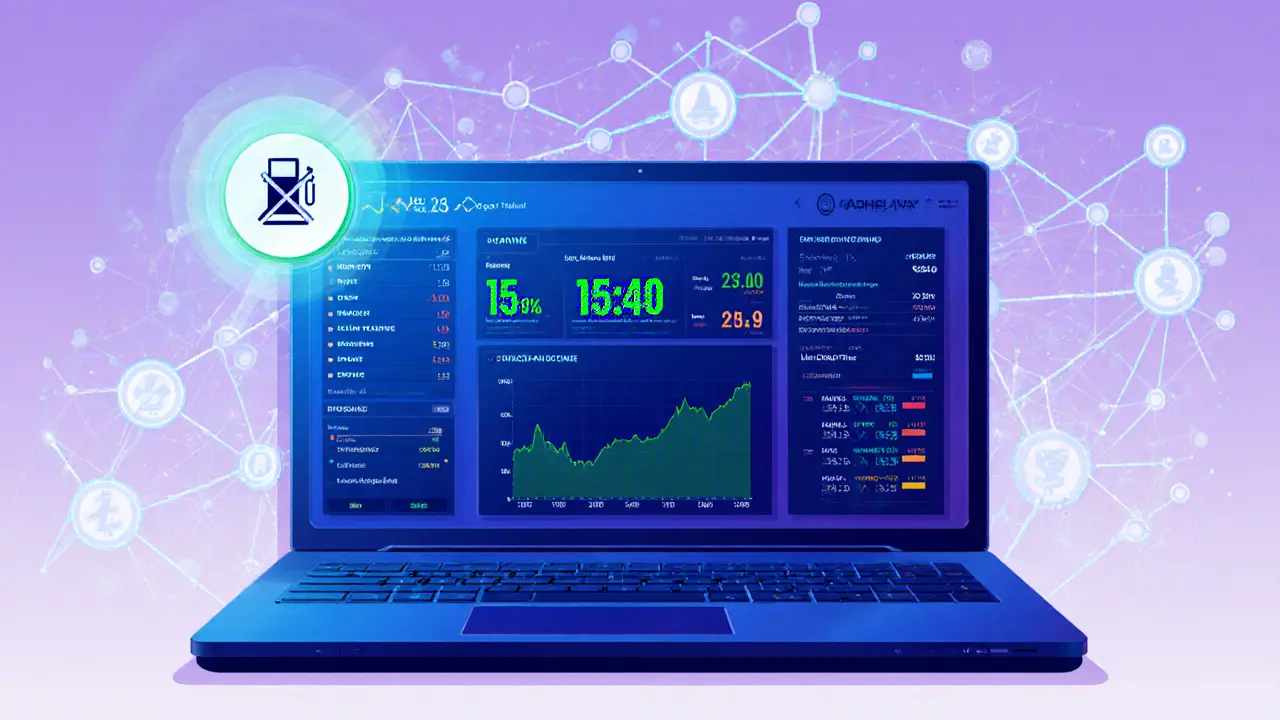ViteX Trading Cost Calculator
ViteX charges a flat 0.20% fee per trade with no gas fees.
Uniswap v4 charges 0.30% taker fees plus average gas fees of ~$0.20 per trade.
SushiSwap charges 0.25% maker fees plus average gas fees of ~$0.18 per trade.
Cost Comparison Summary
Based on your inputs, ViteX saves you money compared to traditional DEXs.
Monthly Savings with ViteX: $0.00
VX Token Rewards
Earn VX through trading, staking, and market-making.
Minimum Stake: 10 VX
Zero Gas Fees
No additional costs for transaction confirmation.
Speed: Sub-second confirmations
Self-Custody
Full control of your assets with local key storage.
Security: Private keys never leave your device
Looking for a decentralized exchange that can keep up with the speed of a centralized platform while sparing you gas fees? ViteX crypto exchange review dives into the mechanics, costs, and user experience of ViteX so you can decide if it fits your trading style.
Key Takeaways
- Sub‑second transaction confirmation thanks to Vite’s DAG‑based ledger.
- No gas fees - the only cost is a flat 0.20% maker/taker fee.
- Only four trading pairs (VITE, BTC, ETH, USDT) limit diversification.
- VX token stake (min10VX) unlocks dividend rewards and mining opportunities.
- Support is community‑driven; no dedicated phone or email help desk.
What Is ViteX?
ViteX is a decentralized cryptocurrency exchange built on the Vite public blockchain. The platform offers a fully on‑chain order book, limit‑order matching, and a self‑custody wallet that stores private keys locally on the user's device.
Underlying Architecture
The speed advantage comes from Vite’s directed acyclic graph (DAG) ledger. Unlike traditional blockchains that add blocks linearly, DAG lets multiple transactions confirm in parallel, delivering confirmation times under one second. Coupled with an asynchronous architecture, ViteX can match orders on‑chain without the latency typically seen on Ethereum‑based DEXs.
ViteX also benefits from its status as a decentralized exchange (DEX). Users retain full control of their assets, and the platform does not hold custody of funds. Smart contracts automate dividend distribution to VX holders, making the reward system transparent and trustless.
Trading Pairs, Fees, and Order Types
At launch ViteX supports four primary pairs: VITE, BTC, ETH, and USDT. While the selection is modest, each pair benefits from the platform’s fee‑free gas model.
The exchange charges a flat 0.20% fee for both makers and takers. Because ViteX eliminates gas fees, the total cost per trade can be considerably lower than on Ethereum DEXs where users often pay 0.002-0.01ETH per transaction.
Currently only limit orders are available. The roadmap lists market orders and stop‑loss orders as upcoming features, a move that should broaden appeal to traders who need more dynamic execution tools.
VX Token - Mining, Staking, and Dividends
ViteX’s native token, VX, is central to the ecosystem. Users can acquire VX through five mining methods: trading, staking, market‑making, referrals, and listing. To earn dividend payouts, a minimum stake of 10VX must be locked in the exchange account. Dividends are automatically distributed via smart contracts, creating a passive income stream for active participants.
VX also serves as a governance token, allowing holders to vote on future upgrades and fee‑adjustment proposals. This adds a layer of community‑driven direction that many centralized platforms lack.
User Experience & Support
The platform offers a web portal, desktop client, and mobile apps for iOS and Android. The UI is clean, with a three‑pane layout that mimics familiar centralized exchanges - a deep‑water welcome for newcomers. Because private keys stay on the device, security is strong, but users must manage backups themselves.
Support relies on community channels: a Telegram group, Discord server, and a knowledge‑base wiki. There is no dedicated phone line or ticketing system, which some traders find frustrating when urgent issues arise. Response times can vary, especially during high‑traffic periods.
How ViteX Stacks Up
| Feature | ViteX | Uniswap (v4) | SushiSwap |
|---|---|---|---|
| Transaction speed | ≈0.8s (DAG) | ≈12s (Ethereum L2) | ≈15s (Ethereum) |
| Gas fees | None | ~$0.20 per trade | ~$0.18 per trade |
| Trading fee | 0.20% flat | 0.30% (taker) | 0.25% (maker) |
| Supported pairs | 4 (VITE, BTC, ETH, USDT) | Hundreds | Hundreds |
| Order types | Limit only (future market/stop‑loss) | Limit, Market, TWAP | Limit, Market |
| Regulatory status | Unregulated, no US access | Unregulated, US access via compliance layer | Unregulated |
The table highlights ViteX’s speed and zero‑gas advantage, but also its narrow market coverage compared with the broader listings on Uniswap and SushiSwap. For traders who need many altcoins or advanced order types, ViteX may feel restrictive.

Pros, Cons, and Risk Factors
- Pros
- Sub‑second confirmation - ideal for high‑frequency arbitrage.
- No gas fees reduce overall cost of frequent trading.
- Transparent dividend system for VX holders.
- Self‑custody guarantees full control of assets.
- Cons
- Only four trading pairs limit diversification.
- Lack of advanced order types (market, stop‑loss) at launch.
- Liquidity depth is modest compared with larger DEXs.
- No formal regulatory oversight - higher risk for large‑scale investors.
- Customer support is community‑only, which can delay resolutions.
- Risk Factors
- Regulatory uncertainty could affect future access, especially for US users.
- VX token price volatility may affect dividend yields.
- Network security relies on Vite’s DAG design - while audited, it’s less battle‑tested than Ethereum.
Future Roadmap and Outlook
ViteX’s development team has outlined several milestones for 2025‑2026:
- Roll out market orders and stop‑loss functionality.
- Expand the list of tradable assets beyond the current four.
- Introduce margin and futures trading modules.
- Enhance customer support with ticketing and live chat options.
- Explore regulatory compliance pathways to open US markets.
If these goals materialize, ViteX could close the feature gap with larger DEXs while retaining its speed and fee‑free edge. However, execution risk remains; many projects announce roadmaps that stall.
Bottom Line
ViteX shines when you value lightning‑fast trades and zero gas costs. It works best for users who focus on the core assets it offers and who are comfortable managing their own keys. If you need a wide array of altcoins, advanced trading tools, or formal regulatory protection, you might look elsewhere. Keep an eye on upcoming feature releases - they could tip the scale toward broader adoption.
Frequently Asked Questions
Is ViteX available to users in the United States?
No. ViteX currently blocks access from US IP addresses due to regulatory uncertainty. Users outside the US can trade freely.
How do I earn VX tokens?
VX can be earned by trading on ViteX (trading mining), staking VITE, providing liquidity (market‑making mining), referring new users, or having a token listed on the exchange.
What security measures protect my funds?
Private keys are stored locally on your device, never on ViteX servers. The platform uses Vite’s DAG consensus, which has been audited for double‑spend resistance. Users should back up their seed phrases securely.
Can I withdraw instantly after a trade?
Yes. Because ViteX settles trades on‑chain, funds appear in your wallet within a second after order execution.
What are the main fees I will pay?
A flat 0.20% maker or taker fee per trade. There are no additional gas fees on Vite’s network.


18 Responses
ViteX’s flat 0.20% fee and zero gas really cuts the cost for frequent traders.
Totally agree, the fee structure makes it easy on the wallet, especially for those just starting out.
Yo, the sub‑second speeds on ViteX are kinda wild, feels like the trade’s done before you even blinked!
Honestly, it’s like watching a high‑speed car chase-except the only thing you’re chasing is profit, and the road has no potholes!
While the zero‑gas claim sounds appealing, it conveniently hides the hidden risk of a less battle‑tested DAG network.
Exactly, you’re basically betting on an unproven consensus, and anyone ignoring that is flirting with disaster.
I see the appeal of the speed 😊, but remember to back up your seed phrase – losing it means losing everything.
Speed without depth is a hollow victory; the market will punish platforms that lack liquidity and robust order types.
From a liquidity‑risk perspective, the limited pair offering may induce slippage spikes, undermining execution efficiency.
Four pairs? That’s like trying to cook a feast with only salt and pepper – boring as hell.
If the ecosystem expands, the platform could evolve beyond its current skeletal asset list, perhaps unlocking new arbitrage pathways.
The flat 0.20% fee is straightforward, no surprises when you settle a trade.
One must contemplate whether the absence of gas truly signifies cost‑saving, or merely a reallocation of computational overhead.
In the grand tapestry of DEXs, ViteX is a fleeting brushstroke of speed.
But without a diverse menu, that brushstroke quickly dries into a bland canvas.
ViteX certainly brings a refreshing breeze to the often sluggish world of decentralized exchanges. Its sub‑second confirmation times feel almost magical compared to the usual wait on Ethereum layer‑2 solutions. For traders who thrive on frequency, that speed translates directly into tighter arbitrage windows and less exposure to market volatility. The flat 0.20% fee, coupled with the complete lack of gas costs, simplifies budgeting and lets users focus on strategy rather than hidden expenses. Moreover, the self‑custody model preserves personal control, which aligns with the core ethos of decentralization. While the current four‑pair offering may seem limiting, it also means deeper liquidity and lower slippage within those core assets. The VX token rewards program adds an extra layer of incentive, effectively turning active trading into a potential passive income source. Staking just ten VX to unlock dividends is approachable for most users, lowering the barrier to participation. Community‑driven support, though sometimes slower, fosters a sense of shared ownership and collective problem‑solving. The roadmap’s promise of market orders, stop‑loss functionality, and expanded asset listings hints at a future where ViteX could rival larger DEXs. If those milestones are met on schedule, the platform’s speed advantage would become even more compelling. Regulatory uncertainty remains a concern, especially for U.S. users, but many innovative projects navigate these waters successfully. Security‑wise, Vite’s DAG consensus has undergone audits, offering a degree of confidence despite being newer than Ethereum. In the end, ViteX is a solid choice for traders who prioritize speed, low fees, and self‑custody above a massive token catalog. It may not yet satisfy the needs of those chasing every altcoin, but its focused approach has its own merits. Keep an eye on the upcoming features, because they could turn this niche DEX into a mainstream contender.
Sounds promising but will the community handle the growth?
Yeah, because who needs more than four coins? Just perfect, right?